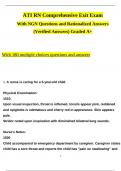ATI RN Comprehensive Exit Exam
With NGN Questions and Rationalized Answers
(Verified Answers) Graded A+
With 180 multiple choices questions and answers
1. A nurse is caring for a 5-year-old child
Physical Examination:
1510:
Upon visual inspection, throat is inflamed, tonsils appear pink, reddened
and epiglottis is edematous and cherry red in appearance. Skin appears
pale.
Stridor noted upon inspiration with diminished bilateral lung sounds.
Nurse's Notes:
1500
Child accompanied to emergency department by caregiver. Caregiver states
child has a sore throat and reports the child has "pain on swallowing" and
1/
79
,denies cough. Child is agitated and lean: Condition: Epiglottis
Actions: Initiate droplet precautions and request a prescription for IV antibiotics
Monitors: Breath sounds and temperature
The nurse should anticipate initiating droplet precautions and requesting a
prescrip- tion for IV antibiotics. The child is most likely experiencing epiglottis
because of the clinical manifestations of a high fever, inflammation and redness of
the throat, pale skin, stridor with inspiration, painful swallowing, no cough, is sitting
in tripod position, and drooling. The nurse should monitor the child's temperature
and breath sounds.
2. A nurse is caring for a client who is on the spinal cord injury (SCI) unit
Nurses' Notes
Day 3, 1700
Client admitted to SCI unit 3 days ago following C7 injury. Skin is cool, pale,
and dry to touch. Respirations easy and unlabored. Lung sounds
diminished in lower lobes. Abdomen soft and nondistended with active
bowel sounds.
Client passed a small amount of hard formed stool this AM. Indwelling
urinary catheter draining clear yellow urine. Deep tendon reflexes (DTR) are
biceps 1+, triceps 1+, pa: The client is most likely experiencing manifestations of
pneumonia and autonomic dysreflexia.
The nurse should analyze cues from the client's manifestations and determine that
2/
79
,the client is most likely experiencing manifestations of pneumonia and autonomic
dysreflexia. A client who has a cervical SCI is at risk for respiratory complications
because spinal innervation to the respiratory muscles is disrupted. Adventitious
breath sounds in the lower lobes bilaterally and a decrease in oxygen saturation
to less than 92% can indicate pneumonia. The client's sudden increase in blood
pressure, bradycardia, flushing of the skin above the area of the injury, headache,
and blurred vision are manifestations of autonomic dysreflexia, which can be a
life-threatening condition.
3. A nurse is caring for a client who has abdominal pain
Nurses' Notes
0900
Client reports loss of appetite, weight loss, and fatigue for 1 week. Reports
abdominal pain, 6 on a scale from 0 to 10, for 2 days. Client is a
perioperative nurse, returned 1 week ago from a 2-week mission trip to an
underdeveloped country
1200
Results of antibody studies obtained. Provider prescription for antiviral
med- ication pending.
Physical Examination
0930
Lung sounds clear bilaterally. Skin warm to touch and jau: Hepatitis A:
3/
79
, Client's risk from fecal-oral transmission, laboratory results, and physical
examination find- ings
Hepatitis B: Antiviral treatment, laboratory results, client's risk from bloodborne
transmission, physical examination findings
Hepatitis C: Antiviral treatment, laboratory results, client's risk from bloodborne
transmission, and physical examination findings
When analyzing cues, the nurse should recognize that manifestations of hepatitis
A, hepatitis B, and hepatitis C include jaundice, yellow sclerae, right upper
quandrant pain upon palpation, dark yellow urine, and elevated AST and ALT
levels. When analyzing cues, the nurse should also recognize the client's risk for
contracting hepatitis A through the fecal-oral route during recent travel to an
underdeveloped country and the client's occupational risk as a perioperative
nurse for contracting hepatitis B and hepatitis C through bloodborne transmission.
The nurse should recognize that the current standard of practice for
4. A nurse is caring for a client on a medical-surgical unit
Vital Sign
4/
79




